My trip to Napoli (Naples) in May 2007
Part One: Napoli during the week
I was sent by Boeing to the SAE A21 meeting in Napoli 16-18 May 2007. A21 is a
committee which writes recommendations for how to model airplane noise and emissions. I
was doing emissions.
I travelled over on British Airways from Seattle to London (Heathrow), then took a
bus to London (Gatwick) for the flight to Napoli. This meant I had to clear customs
twice in each direction. I took a bus between the two airports, and both times I had
just enough time. It takes 2-3 hours to get your luggage, clear customs, take the bus,
check in again, and get to your flight. Boeing pays for business class for international
travel, but BA offered a free upgrade to first class for the transatlantic legs. That
was really nice. Excellent food, lots of space, excellent service. I could get used to
that, if only I could afford it.
Because of the time zones, I got onto the plane Monday evening Seattle and got off
the plane late Tuesday night in Napoli. I'm not really fond of cabs, but having a car in
Napoli would have been a disaster. The local traffic operates by some sort of strange
rules that are not at all apparent to outsiders and have little or nothing to do with
the signs and lane markings and traffic signals. So I took the cab to my hotel.
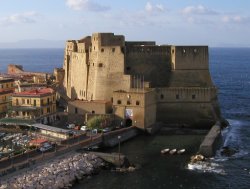 Here's a picture of the view from outside my window the next
morning. This is the Castel
dell'Ovo ("Egg Castle").
There has been something built on this site for 2600 years now. The current castle dates
back about 500 years. According to medieval legend, the poet Virgil had a magical egg
placed under the foundations of the castle. (During the whole time I was there, I
thought the castle was called "dell'Oro" -- "of gold" -- for the color. It was only
after I got back and looked it up on the web that realized this golden-colored castle
was called "Egg Castle". What's really funny is that while I was there I was making
jokes about having to go home and look it up on the web to know what I was seeing --
turns out I was more right than I knew!)
Here's a picture of the view from outside my window the next
morning. This is the Castel
dell'Ovo ("Egg Castle").
There has been something built on this site for 2600 years now. The current castle dates
back about 500 years. According to medieval legend, the poet Virgil had a magical egg
placed under the foundations of the castle. (During the whole time I was there, I
thought the castle was called "dell'Oro" -- "of gold" -- for the color. It was only
after I got back and looked it up on the web that realized this golden-colored castle
was called "Egg Castle". What's really funny is that while I was there I was making
jokes about having to go home and look it up on the web to know what I was seeing --
turns out I was more right than I knew!)
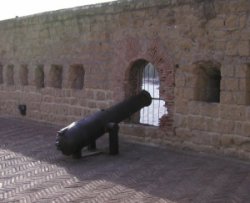 During the day you can walk up to the top of the castle. These
cannon were on top. What I found interesting is that all the cannon and all the gun
firing slits all pointed back to Napoli or the causeway leading to the castle. Clearly
it was not designed for harbor defense -- it was designed to protect whoever lived there
from attack overland. One cannon was pointed back at my
hotel.
During the day you can walk up to the top of the castle. These
cannon were on top. What I found interesting is that all the cannon and all the gun
firing slits all pointed back to Napoli or the causeway leading to the castle. Clearly
it was not designed for harbor defense -- it was designed to protect whoever lived there
from attack overland. One cannon was pointed back at my
hotel.
It's a very romantic place, and apparently it is popular for weddings. While I was up
there I saw a wedding party getting photos taken.
This herringbone brick pattern was very interesting.
But what's that in the corner? Hmm, I don't think this wi-fi was original equipment. On the causeway the lamp
posts are all wrapped with chains with locks. Apparently
this is a popular thing to do for lovers or weddings or something. The locks all had
names and dates written on them.
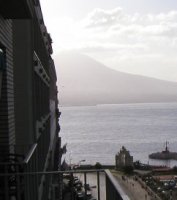 I was also able to see this mountain from my hotel balcony. At
first I wasn't certain whether this was Vesuvio (Vesuvius) or not ... but yes, it was.
It was both closer and smaller than I expected. In the Pacific Northwest, our volcanoes
are much larger but also more remote. In Italy there just isn't much of what we in
America would call wilderness. Later on in the week I took a bus ride up to the top of
the mountain. (The bus went up to about 100 meters below the crater rim. A trail went to
the rim and about halfway around it, but not to the summit.) Vesuvio is a national park,
part of the same park as the ruins of Pompeii and Erculeum.
I was also able to see this mountain from my hotel balcony. At
first I wasn't certain whether this was Vesuvio (Vesuvius) or not ... but yes, it was.
It was both closer and smaller than I expected. In the Pacific Northwest, our volcanoes
are much larger but also more remote. In Italy there just isn't much of what we in
America would call wilderness. Later on in the week I took a bus ride up to the top of
the mountain. (The bus went up to about 100 meters below the crater rim. A trail went to
the rim and about halfway around it, but not to the summit.) Vesuvio is a national park,
part of the same park as the ruins of Pompeii and Erculeum.
Walking around I saw lots of interesting things. One of the most obvious was that
Japanese cars were quite rare, but Italian and French cars
were very common. There were Alfas, Pugeots,
Fiats, and Renaults all over the place. Also a fair number of Smart cars. Most of
these cars, like this Alfa, just had a very different look than
cars in America. Others, like the BMWs, looked exactly the same. And almost all the
cars, trucks, busses, and vans were smaller than in the US. Most different, though, was
the amazing number of scooters and motorbikes all over the place. It seemed like almost
everyone had one, and that the operators had a collective deathwish. I even saw whole
families (dad, mom, child) riding on the same scooter. (Just like in the US, some of
these cars were "special". I saw a young guy taking a picture of a car, so I stopped to
see what it was. The door lock was punched out, and the door was opened by a wire tied
around a stick that pulled the lock mechanism. He laughed and said something in Italian
about it "especiali" or something like that. I laughed and said "yes; si".)
But there were also things you just can't imagine seeing in the US. Like this structure. I couldn't figure out what it was, but it had
the same construction as the Castel dell'Ovo. It's about a block away from the entrance
to the causeway leading out to the castle. Some more special
cars were nearby. Right across the street was evidence
that Italians can be concerned about their cholesterol and want to have "perfect eyes".
Another local shop that seemed popular was "Original Marines", which featured American
flag themes but had as much to do with the USMC as Old Navy does with the Navy. In fact,
it was basically Old Navy with a different name and prices in euros.
There were no yards anywhere, and not many parks. Basically, whether you were an
adult, a child, or a dog, you did what you did out in
the sidewalks. That included a lot of people who were doing this. This particular couple held that pose for long enough that I
wondered if they were asleep. Got to say, it's a very romantic place for it! (Assuming
you don't mind the complete and total lack of privacy and the very busy traffic.) That
island behind them is Capri.
Another thing that was done in the streets was eating. I ate breakfast every day in
the hotel (Eating breakfast is not really a very Italian thing to do, apparently -- the
hotel was the only choice available.) But aside from that, I think every meal I had was
outdoors. There were indoor eating places, and many places with tables inside and
outside. But mostly it seems people either ate at sidewalk tables or grazed from street
vendors. In Pompeii and Erculeum it seemed clear that this tradition was the same 2000
years ago.
Part Two: Saturday -- Pompeii
On Saturday it turned out that many of the folks from the meeting were going to
Pompeii. I was going to meet some of them, but the travel finally caught up to me and I
was not 100% Saturday morning. However, after a short delay I ended up making my way out
to the train station (by cab). Catching the train was easy, but catching the right one
was not. I actually got onto the wrong train but realized my mistake before it was too
late. I got off and waited for the right one to come by. Once on the right train, it was
simply a matter of getting off at the Pompeii Scavii (excavation) station.
I would definitely recommend hiring a guide if you have a small group of people. It
was just too spendy for one person, but even for three or four it would have been well
worth the money. How often are you going to get back to Pompeii? And while they handed
out an excellent map with a decent little guidebook, it's not the same as having an
expert with you. Oh, and bring lots of water!
 The main gate to the excavation is at the "Sea Gate" to the town
(so-called because it was the road to the sea). The forum is
near the gate. This was the commercial and religious and judicial center of the town. In
fact, for Romans those were basically all the same thing. The bankers and priests and
judges were all pretty much the same group of people. Vesuvius looks comfortably far
away. I can imagine why some people thought they were safe to stay in town. (Most of the
residents actually escaped.)
The main gate to the excavation is at the "Sea Gate" to the town
(so-called because it was the road to the sea). The forum is
near the gate. This was the commercial and religious and judicial center of the town. In
fact, for Romans those were basically all the same thing. The bankers and priests and
judges were all pretty much the same group of people. Vesuvius looks comfortably far
away. I can imagine why some people thought they were safe to stay in town. (Most of the
residents actually escaped.)
OK, just in case you don't know -- Pompeii was a Roman town that was severely
damaged by an earthquake in 62 CE. Then, seventeen years later (79 CE), it was destroyed
by an eruption of Vesuvius. Most of the town evacuated but about 20% stayed in town and
were killed by pyroclastic flows. Those same flows destroyed the wooden roofs. But much
of the town was actually preserved because it was buried in ash and pumice. It was
rediscovered in the 1800s. Unfortunately for modern visitors, everything that seemed
interesting or artistic was stripped from the town at that time and taken away to
museums. A lot of the "ruin" of Pompeii came from this stripping. The rest comes from
200 years of tourism and exposure to the weather. I was a little disappointed by how
much of Pompeii was closed to visitors, but I guess they want to conserve some of it for
the future. About 25% is still buried.
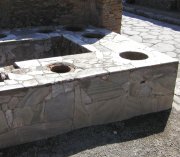 From the forum I wandered up towards the Villa Of Mysteries
(named for some paintings still on the walls there,
depicting a woman being taught about how to become a wife). This house was a suburban
villa just a little ways outside the gate leading off to Erculeum. While I was going out
there I saw some things that were extremely common all over town. One was this lunch
counter. This was basically a fast food place, where hot food was served out of jars set
into the counter. Romans rarely ate lunch at home. Almost every block had one of these,
and near major public areas they were even more common. There are about 100 of them in
town.
From the forum I wandered up towards the Villa Of Mysteries
(named for some paintings still on the walls there,
depicting a woman being taught about how to become a wife). This house was a suburban
villa just a little ways outside the gate leading off to Erculeum. While I was going out
there I saw some things that were extremely common all over town. One was this lunch
counter. This was basically a fast food place, where hot food was served out of jars set
into the counter. Romans rarely ate lunch at home. Almost every block had one of these,
and near major public areas they were even more common. There are about 100 of them in
town.
The streets were also the storm drains (and sewers, I think). Everywhere there were
raised sidewalks with stepping stones linking
them. Another common sight was the iron gates and "area closed" barriers. It's a big
town with lots to see, but even so it is frustrating how much of it is closed off. The
stepping stones were all the same height and width, allowing regulation carts to roll
past them. You can still see the grooves in the paving stones
from the carts.
Something else you see all over are these lizards. Not quite
so common was this bakery with its flour mills and brick oven. In fact, almost everything is made of bricks
(which is why the town was destroyed by the earthquake). The walls and columns are
generally brick covered by plaster. But a few appear to be concrete (an important Roman invention).
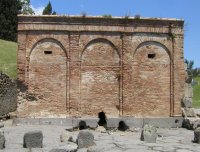 A couple of years ago my dad (a water department engineer) loaned
me a book by Robert Harris called Pompeii. It was a novel about a Roman water
department engineer who is assigned to run the water system for the area just a week
before the eruption. It's a good novel. In the end, he escapes the eruption with his
lady love by crawling up the (dry) underground aquaduct leading from the city. This
avoided the searing and poisonous pyroclastic flows that killed everyone else. It's
obvious where Harris got this idea, because the entrance
to the aquaduct is still visible from inside this water building. The three holes
you see on the building fed three separate water systems. A sluice gate allowed the water to be distributed. One system
was for private homes, one was for public baths, and one was for the public fountains.
In times of low water, the public fountains were kept flowing while the others were shut
off (because that's where people got their drinking water). These were gravity fed (the
water building is at the high point of town). They ran through pipes made of lead sheets that were rolled and then soldered
on top.
A couple of years ago my dad (a water department engineer) loaned
me a book by Robert Harris called Pompeii. It was a novel about a Roman water
department engineer who is assigned to run the water system for the area just a week
before the eruption. It's a good novel. In the end, he escapes the eruption with his
lady love by crawling up the (dry) underground aquaduct leading from the city. This
avoided the searing and poisonous pyroclastic flows that killed everyone else. It's
obvious where Harris got this idea, because the entrance
to the aquaduct is still visible from inside this water building. The three holes
you see on the building fed three separate water systems. A sluice gate allowed the water to be distributed. One system
was for private homes, one was for public baths, and one was for the public fountains.
In times of low water, the public fountains were kept flowing while the others were shut
off (because that's where people got their drinking water). These were gravity fed (the
water building is at the high point of town). They ran through pipes made of lead sheets that were rolled and then soldered
on top.
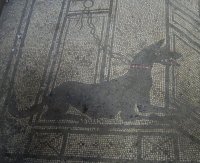 Another common sight was mosaics showing dogs. I saw at least
three of them in the doorways of houses. One famously spells out the words "CAVE CANUM"
-- "Beware Of Dog". (I couldn't get a good picture of that one due to the light.) This
one was in a house with an elaborate mosaic over the
entire floor, all showing animals. Apparently many of the other houses had similar
mosaics, but they were destroyed when the highlights were removed and shipped off to
museums. This house was gated off, but a woman was inside taking some notes or making a
sketch.
Another common sight was mosaics showing dogs. I saw at least
three of them in the doorways of houses. One famously spells out the words "CAVE CANUM"
-- "Beware Of Dog". (I couldn't get a good picture of that one due to the light.) This
one was in a house with an elaborate mosaic over the
entire floor, all showing animals. Apparently many of the other houses had similar
mosaics, but they were destroyed when the highlights were removed and shipped off to
museums. This house was gated off, but a woman was inside taking some notes or making a
sketch.
People being what they are, one of the most famous places in Pompeii is the brothel.
Apparently this is the only brothel in town known to be purpose-built, but it probably
wasn't the only place in town where the goods were for sale. Inside are some little
rooms with stone beds. I sure hope they had some padding of
some sort that they put on them! Above the rooms were some frescos showing what you might expect to be
purchasing. [1] [2] [3] The brothel also had a room dedicated
to another one of those common human functions. This house was notable for being
reconstructed (or at least reroofed) and having electric lights installed. There was
also a sign on the door telling us "no flash" in various languages. Apparently the vast
quantity of erotic art found in Pompeii and Erculeum shocked the people of the 18th and
19th centuries. It had been assumed that the Romans were dour, stoic, no-nonsense
people. I don't know why -- Italians today are generally nothing like that.
But not everything that was shocking was necessarily intended to be erotic. Consider
this fresco. This is intended to be a statement about balance
of commerce and family. Or maybe it's just the old joke about how if you have a Ferarri
you don't need a big ... well, you probably know the joke.
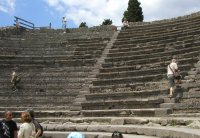 So, what about entertainment? Well Pompeii had two theaters, right
next to each other. One was very large, and the other (shown in the picture) was more
intimate. This is what it looked like to be
sitting about halfway up in the center of the small theater. That area that now has
grass was apparently a raised stage, and the whole thing was roofed.
So, what about entertainment? Well Pompeii had two theaters, right
next to each other. One was very large, and the other (shown in the picture) was more
intimate. This is what it looked like to be
sitting about halfway up in the center of the small theater. That area that now has
grass was apparently a raised stage, and the whole thing was roofed.
The large theater next door appears slightly more
ruined, but actually it is still in use. There are some metal frames used to support
temporary seats and stages. Every year, they have a festival where they bring in
performers and put on shows and concerts in the main theater. There was a whole other
level of seating built up above the lower bowl, allowing a great number of people
(several thousand) to be in the audience. It was apparently covered by a cloth tent
roof.
Nearby is a courtyard that seems to have acted as the foyer for the two theaters. It
was hard to try and capture the size of some of these courtyards, because the camera
does not do justice to the scale.
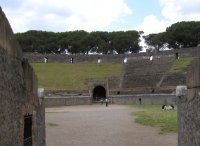 But the theaters are nothing compared to the stadium! This is the
view from the exit of the amphitheater. The victorious fighters would leave from here
(entering from the other side). The view from inside is
quite impressive. However, the stands are closed off so I'm not sure what it would have
looked like as a spectator. This was apparently the site of a large riot a few years
before the earthquake, where people from Pompeii got into a fight with fans from a
nearby town. Some things just don't change. From the
outside, the amphitheater looks just like many modern stadiums. The Roman arch and
Roman architecture survive to this day. (Greek theater design, however, generally does
not, because modern theaters are designed around indoor spaces and artificial
lighting.)
But the theaters are nothing compared to the stadium! This is the
view from the exit of the amphitheater. The victorious fighters would leave from here
(entering from the other side). The view from inside is
quite impressive. However, the stands are closed off so I'm not sure what it would have
looked like as a spectator. This was apparently the site of a large riot a few years
before the earthquake, where people from Pompeii got into a fight with fans from a
nearby town. Some things just don't change. From the
outside, the amphitheater looks just like many modern stadiums. The Roman arch and
Roman architecture survive to this day. (Greek theater design, however, generally does
not, because modern theaters are designed around indoor spaces and artificial
lighting.)
Near the stadium (which is a substantial walk from the forum -- tourists with only a
few hours never even see it), some of the town seems to have survived a bit better.
Either that or it has been reconstructed a bit more. The streets seem less like ruins and more like an old town. There were
many more lunch counters and more intact mosaics. I suspect that this area was excavated a little later,
when there was a bit less emphasis on hauling everything off to museums and a bit more
on leaving things in context.
I took more pictures and saw more things (including a relatively intact bath
complex), but after a while you reach overload. This town was big! And about 25% of it
is still buried, left in trust for the future. Once things are dug up, they are
vulnerable. In fact, apparently Pompeii was bombed during World War 2. I'll leave you
with what I left with -- the view from the exit. After spending
about six hours in here, it was something of a shock to see the
modern houses just outside the city walls.
As I was leaving I ran into some other folks from the meeting, including the only
other Boeing person. Turns out they had hired a private car to take them to Erculeum,
Vesuvio, and Pompeii for about 100 euros total. That's not a bad deal (for four people),
if you only have a single day and you want to maximize your time at the main sites.
However, by doing it in two days I was able to spend a lot more time in Pompeii, and
then I stopped at the National Archeology Museum on the way back. This is where many of
the best artifacts from Pompeii were taken. Unfortunately, in what was a common theme to
the trip, not all of the museum was open. But I did see a lot of cool stuff there,
including the "secret room" which is where they gathered all the erotic artwork. The
next day I took the train again, this time going to Erculeum and then from there taking
a van up to Vesuvio.
Part Three: Sunday -- Erculeum and Vesuvio
On Sunday I decided to go to Erculeum and Vesuvio. There are many ways to get to
Vesuvio, but the easiest to arrange is to take a bus. The national park runs busses from
Erculeum and Pompeii (and also one from Garibaldi train station in Napoli). The busses
run more frequently from Pompeii, but I was going to be at Erculeum. So I decided to
take the train early enough to see Erculeum first, then catch the bus at 12:45, see
Vesuvio, ride back, and then make my way back to Napoli by train. Nice plan, but none of
it happened like I expected.
Catching another taxi to the train station was fine, and this time I got on the right
train. I felt like a expert by now. I got off at Erculeum. But unlike Pompeii, the train
station at Erculeum does not drop you off right at the park entrance. And I had no idea
where the busses start from. But a guy was out there drumming up business, "Autobus to
Vesuvio?" and pointing to a storefront. I went over to check the time and price, and
they were the same as in my guidebook. As I was leaving the shop, a guy walked up to me
and asked if I spoke English. I did, and it turned out he was a slightly lonely Aussie
who had been in Rome for a week and was just looking for somebody to chat with. Over the
course of the morning I found out that he had been in the UK for about six months,
living with a woman who he was going to marry. But that fell through, and here he was in
Italy seeing some sights before heading back to Australia. He was probably about 30.
So we headed out to Erculeum. I wasn't sure if the free entrance still applied, but
it did. Unfortunately, I didn't find a handy map and guidebook like I did for Pompeii,
so we were somewhat on our own.
 Pompeii is up on the top of a
hill, but Erculeum is (now, anyway) below the level of the surrounding town. As you
enter, you walk along a bridge structure that looks out over the excavation site. You
can see the surrounding town is built right on top of the old town. In fact, it seems
that only a small part of the old town has been excavated because people are living on top of the rest of it.
Pompeii is up on the top of a
hill, but Erculeum is (now, anyway) below the level of the surrounding town. As you
enter, you walk along a bridge structure that looks out over the excavation site. You
can see the surrounding town is built right on top of the old town. In fact, it seems
that only a small part of the old town has been excavated because people are living on top of the rest of it.
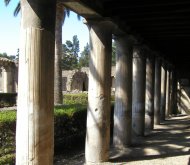 Erculeum was built with pretty much the same construction techniques as Pompeii. So a lot of it
was very similar, but it still had a very different feel to it. Pompeii felt like ruins
that had been exposed for thousands of years (instead of hundreds), but Erculeum felt
more like it had been dug up in the past decade. It was smaller, more intimate, less
impressive, but also less damaged. There were a lot more roofs
still existing or reconstructed. On the other hand, some things were very familar from Pompeii.
Erculeum was built with pretty much the same construction techniques as Pompeii. So a lot of it
was very similar, but it still had a very different feel to it. Pompeii felt like ruins
that had been exposed for thousands of years (instead of hundreds), but Erculeum felt
more like it had been dug up in the past decade. It was smaller, more intimate, less
impressive, but also less damaged. There were a lot more roofs
still existing or reconstructed. On the other hand, some things were very familar from Pompeii.
One thing that interested me, as an engineer, was the strange mix of construction
techniques used in the towns. In one wall you
might see brick and mortar, layers of brick interspersed with layers of stone, just
stone, arches buried in the wall, lintel beams, and more. I suspect this may reflect
that the town was partially destroyed by an earthquake, so some of these walls may have
been patched up.
The town had the same kind of sunken streets as
Pompeii. More of the floor mosaics and wall frescos were still intact. But the town was less
impressive as a town, because it was really more of a fragment of a town. More
decorative elements were still in place, including this skylight. (In a Roman house, these were just open, allowing
rainwater to fall into a pool in the center of the
atrium.) Some houses were a little more imposing than
others.
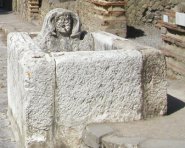 As in Pompeii, most of the people got their water from public
fountains. Houses often had small shrines, presumably
to the god that they favored. One house had this elaborate structure that I would guess was a shrine.
Probably it was a shrine to some god associated with the sea. The trim work is made out
of scallop shells. In the same room, this mosaic obviously
was part of the same artistic theme.
As in Pompeii, most of the people got their water from public
fountains. Houses often had small shrines, presumably
to the god that they favored. One house had this elaborate structure that I would guess was a shrine.
Probably it was a shrine to some god associated with the sea. The trim work is made out
of scallop shells. In the same room, this mosaic obviously
was part of the same artistic theme.
Erculeum has what is supposed to be the best preserved Roman sunken baths in
existance. Unfortunately, they were closed. They looked awesome through the window. In several places (including those
closed baths) we saw small target stickers stuck on the wall. This was part of an
ongoing effort to make a 3D digital record of the town. Near the sunken baths was a very
interesting statue. What was neat was that it was
broken, and you could see that the statue was actually made out of concrete, with a
plaster covering on the outside that provided the detail. Behind the statue was the ramp
we descended to get there, built using the Roman arch
technique.
While the great sunken baths were closed, another bath
complex was open. The baths had a bunch of separate rooms, with all sorts of
interesting features. It was hard to be sure what
everything was for, but sometimes it was obvious. For instance, one room appeared to be
something of the locker room, with partitioned shelves
where people could stow their stuff during the time they spent in the baths.
Eventually we started running out of time, so we headed out and picked a random
trattoria for lunch. After having spent about three hours together, we finally exchanged
names. My Aussie companion was named Ron. Ron decided that he would visit Vesuvio later,
so he went back to Napoli. But I gave him my hotel info so we could meet up for
dinner.
When I got back to the train station, a large van called "Vesuvio Express" was just
about to leave. I bought a ticket. Turns out this seems to be a private service that
leaves from the same location just before the public bus does, skimming off the
passengers. But it wasn't much more expensive and I enjoyed the experience more than I
would have in a large bus. Since they were full, I sat up in front next to the driver,
which was definitely the best seat in the house.
Italian traffic seems crazy, but once we got onto the mountain road I suddenly felt
like I was in my comfort zone. I've driven up a lot of narrow mountain roads, and this
was remarkably like the road up to Paradise at Mount Rainier. The traffic was mixed
between tourists who were going slow and experienced drivers who just wanted to get
there. One difference between the Vesuvio road and the Paradise road was that instead of
old growth forest, the Vesuvio road went up through statues. Yes, there were huge
statues all along the road -- some sort of public art initiative from the national park.
Apparently they were slightly controversial because none of them were by local
artists.
At one point on the way up we were stuck in traffic when two full-size busses tried
to get past each other on a switchback. Once that was worked out, we suddenly got
flagged down by a guy on a Vespa coming the other way. While he waved wildly for us to
stop, around a switchback came about 100 Vespas. Some were flying flags or banners that
proclaimed them to be the Vespa Club di Napoli. Many were new, but a few of the scooters
looked to be forty or fifty years old.
Finally we reached the end of the road, which was a crowded parking lot about 1000
meters above sea level. From here a trail headed up the mountain. Just inside the gate
was an old man and woman who were renting walking sticks. (Supposedly "free", a "tip"
was basically required when you returned. I took one, as did almost everyone else. It
was helpful.)
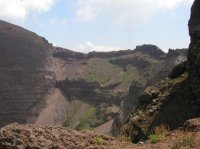 The trail climbed up about another 100 meters (vertical) before
reaching the crater rim. There were a few steam vents visible. Interestingly, I did not get the sulfur smell
that is so common near the craters of the Cascade volcanoes.
The trail climbed up about another 100 meters (vertical) before
reaching the crater rim. There were a few steam vents visible. Interestingly, I did not get the sulfur smell
that is so common near the craters of the Cascade volcanoes.
The trail went about halfway around the crater rim, and then it ended. Along the way
there were several tourist shacks, selling film, gifts, wine from vinyards on the
mountain, postcards, etc. From the last one you looked out over Pompeii. Here's that same image with the area that I
think is Pompeii enhanced and blown up.
Eventually I went back down to the parking lot and got there just in time to catch
the van back down. Then I took the train home (but not before catching the wrong train).
On Saturday I had tried walking back to my hotel from the museum and had gotten lost.
This time I took the subway a few stops farther. I had noticed that while there was no
subway stop that went to where my hotel was, there was a possible route that got me
close. I ended up taking the subway to a funicular line, taking that line up a hill, and
then taking another funicular down another side of the hill. That brought me reasonably
close to my hotel.
Later that evening Ron did call. We ate dinner at a pizza place nearby, and I told
him about Vesuvio. He had gotten lost on the way over (common theme!) and so I showed
him how to get back (being an old hand at Napoli by this time). Then as I walked back to
my hotel I snagged some late night gelato from a street vendor. Just as I was starting
to feel like I knew my way around, it was time to go home.
Part Four: Conclusions and general impressions
Well, I had fun. I also got a lot of work done at the meeting. The pizza was
outstanding, as was most of the food in general. But I didn't find nearly as much
variety of food as in the US. I'm sure part of that was just me hanging around in one
small, touristy part of the city. Still, I wonder if there were any Chinese places, for
instance? I didn't see any.
Racially everyone seemed to be either Italian or African. And I mean really African,
not 400-years-removed-from-Africa like in the US. Clothes were either very casual or
business/conservative. The "business casual" and "REI outdoorsy" looks that dominate
Seattle were almost non-existant.
Not speaking Italian was generally not an issue, but not reading it was a bigger
deal. I suddenly had a small taste of what it must be like to be illiterate. I had to
rely on pictograms a lot. However, many of the people either spoke some English or were
used to dealing with folks who don't speak Italian. And euros work just like dollars
except there does not appear to be any change smaller than ten cents.
My most memorable interaction was with the extremely pretty young woman who sold me a
pastry while I was wandering around lost on Saturday evening. I just kind of pointed to
the one I wanted, and she grabbed it for me. But then she asked me something. I had no
idea what she was asking, and she didn't know how to ask it in English. But when she
took the pastry over to the oven and pointed at it, I finally understood. No, I didn't
want it heated up. This very human interaction just touched me, for some reason. And did
I mention how pretty she was?
Next most memorable was when I got on the wrong train Sunday evening. After I
realized that, I got off at a different station. But I didn't know which track went back
to Napoli. So I asked a guy on track four, and he managed to communicate that I wanted
track three. While I was waiting, an announcement came over the PA saying (I thought)
"train to Napoli, track one". Then this guy got all excited, and flagged me down from
across the tracks. He wanted to make sure I realized I was on the wrong track. I thanked
him and went over to the right one.
The guidebooks talk a lot about how pickpockets and con artists are everywhere in
Naples (especially on the Circumvesuviana train), but I
didn't run into anything like that. On the other hand, I never quite understood the
rules for prices and tipping, and felt like I was probably overpaying for almost
everything. Taxis seemed to be especially bad -- I'm pretty sure the prices were much
higher for non-Italians. The drivers all seemed to have a brother or uncle with a
restaurant in New York.
All in all I had a very interesting experience. This was my first trip to Europe, and
it was something of a total immersion in the sense that I was by myself for most of the
time away from the meeting. I was staying at a different hotel from everyone else
(booked too late to get the group reservations) and I didn't hook up with any of the
meeting participants for dinner or tourism (except the first night).
Also, I was staying at a waterfront hotel and not worrying about how much most things
cost, because it was a business trip. I did pay out of pocket for my recreational
activities, but it turned out I was there during the one week of the year when all the
museums and cultural sites were free. So mostly that meant paying for train tickets, a
few cab rides, and the bus up to Vesuvio. So I don't know how different it would be if I
were staying at a budget hotel, trying to balance my checkbook and maximize my
experience/dollar ratio.
In a sense, travelling by yourself is more rewarding, because you can totally immerse
yourself in the people and places you meet. But I think Napoli would actually be a
better place to visit with a friend.
Contact Information
Email address:
mikegarrison@alum.mit.edu
This address forwards to both home and work. I get a lot of spam, so if I don't know you, be sure to have a descriptive subject line.
 Here's a picture of the view from outside my window the next
morning. This is the Castel
dell'Ovo ("Egg Castle").
There has been something built on this site for 2600 years now. The current castle dates
back about 500 years. According to medieval legend, the poet Virgil had a magical egg
placed under the foundations of the castle. (During the whole time I was there, I
thought the castle was called "dell'Oro" -- "of gold" -- for the color. It was only
after I got back and looked it up on the web that realized this golden-colored castle
was called "Egg Castle". What's really funny is that while I was there I was making
jokes about having to go home and look it up on the web to know what I was seeing --
turns out I was more right than I knew!)
Here's a picture of the view from outside my window the next
morning. This is the Castel
dell'Ovo ("Egg Castle").
There has been something built on this site for 2600 years now. The current castle dates
back about 500 years. According to medieval legend, the poet Virgil had a magical egg
placed under the foundations of the castle. (During the whole time I was there, I
thought the castle was called "dell'Oro" -- "of gold" -- for the color. It was only
after I got back and looked it up on the web that realized this golden-colored castle
was called "Egg Castle". What's really funny is that while I was there I was making
jokes about having to go home and look it up on the web to know what I was seeing --
turns out I was more right than I knew!)










